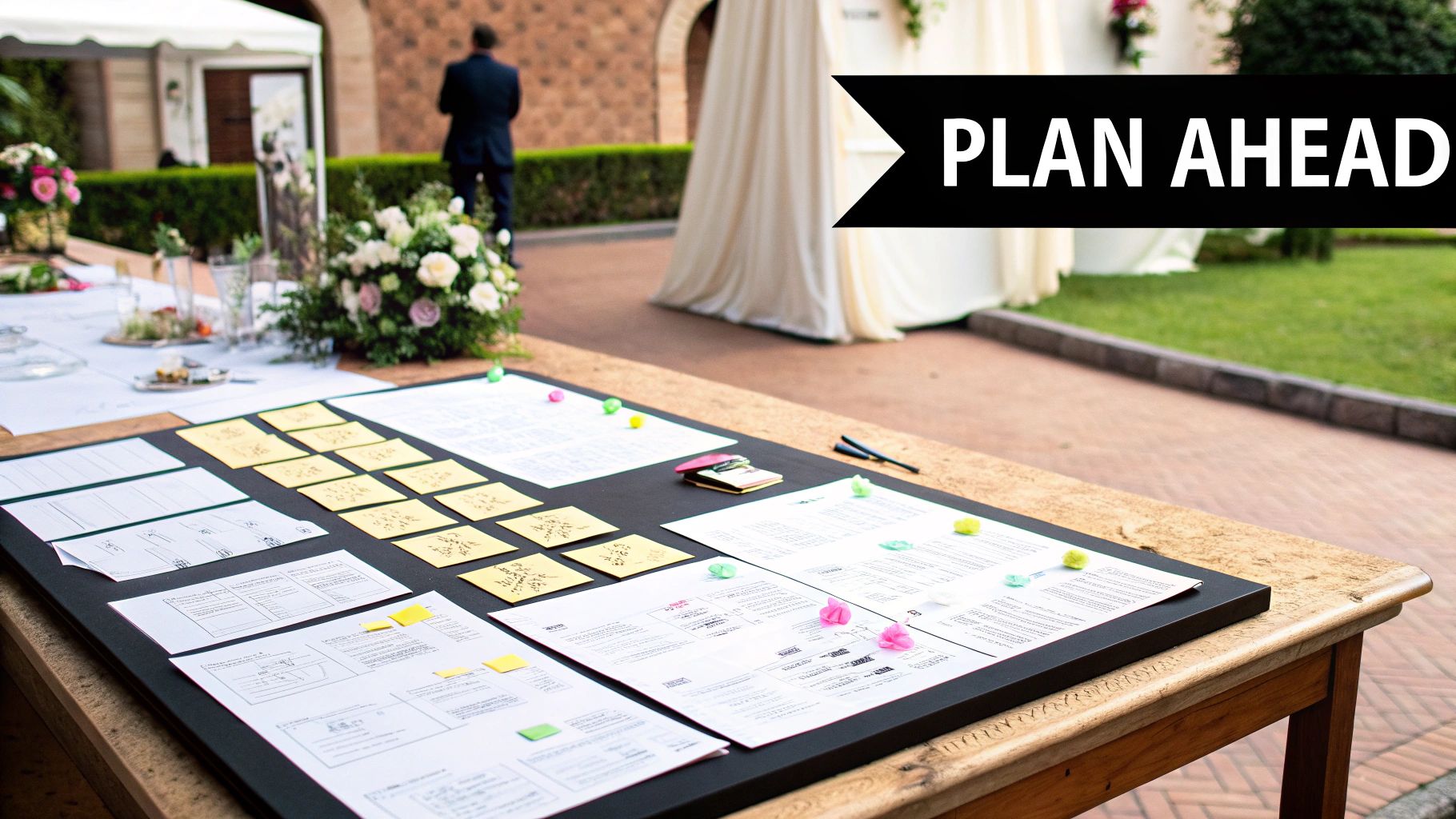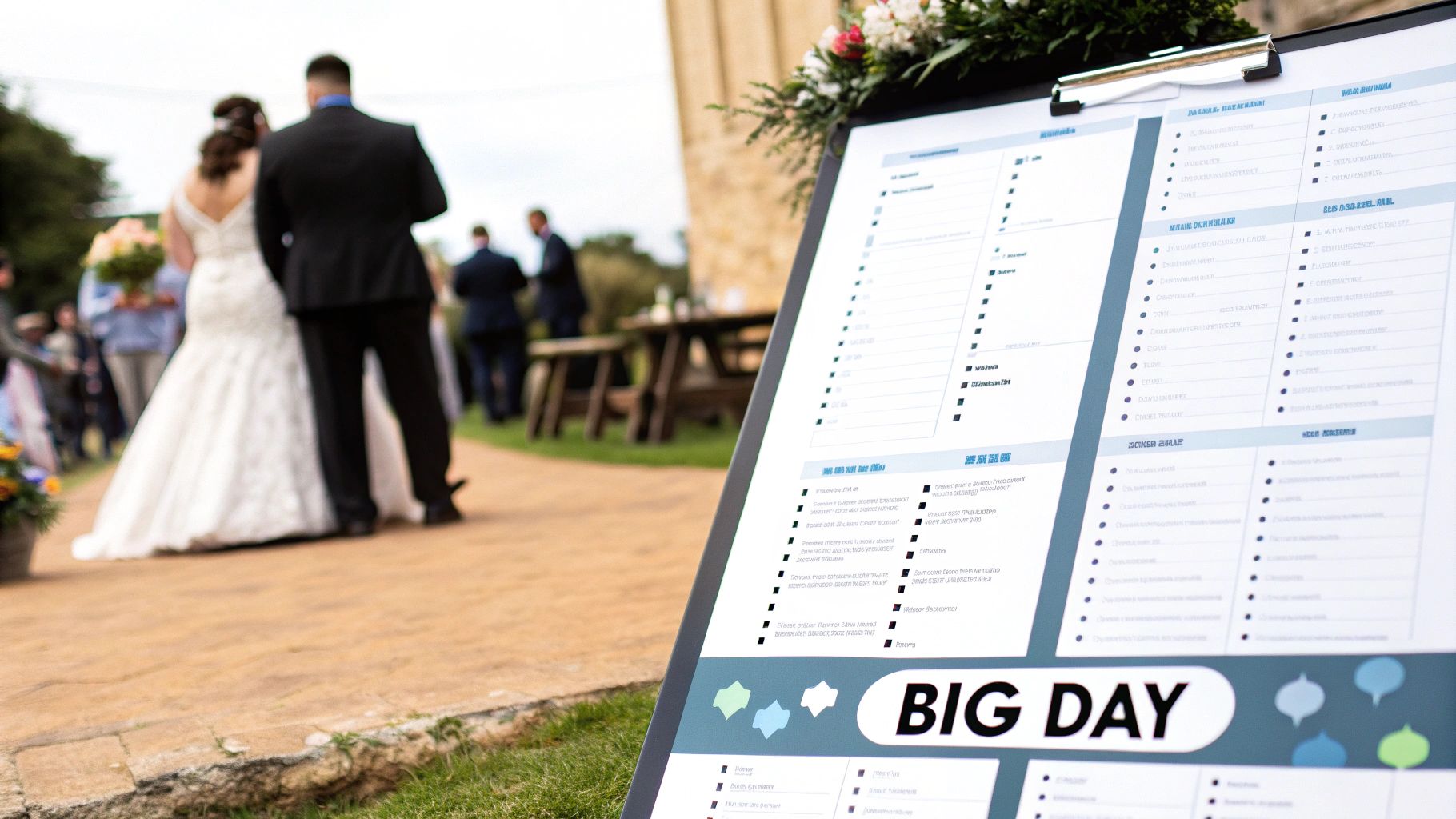Why Every Couple Needs a Wedding Planning Timeline
Planning a wedding is exciting, but it can easily become overwhelming without a clear plan. A wedding planning timeline template acts as your guide, leading you through each step and ensuring a smooth journey to your flawlessly executed wedding day. Consider it a blueprint, keeping everything organized, from venue booking to vendor coordination. This framework provides clarity, especially when facing numerous decisions. It's the foundation for successful weddings.
A well-structured timeline isn't simply about checking off tasks; it strengthens relationships with your vendors. Clear timelines improve communication. Vendors appreciate knowing your expectations and deadlines, enabling them to perform their best work. This collaborative approach minimizes misunderstandings and fosters partnership, creating a smoother planning process. A defined timeline also helps couples manage their budget by allowing better resource allocation and preventing last-minute costs.
Benefits of Using a Wedding Planning Timeline Template
Using a template provides a pre-designed structure, saving you valuable time and energy. These templates are often customizable, adaptable to your specific needs and wedding size. Whether planning a small gathering or a grand celebration, a template can be adjusted accordingly. For example, smaller weddings might require less vendor coordination time, while larger weddings may need a more detailed guest management schedule.
-
Reduced Stress: Break down the planning process into manageable steps, making the overall task less daunting.
-
Improved Organization: Keep track of deadlines, appointments, and vendor communications in one place.
-
Better Budget Management: A timeline facilitates accurate budgeting and avoids unexpected costs.
-
Stronger Vendor Relationships: Clear communication and expectations lead to smoother collaborations.
-
Enhanced Flexibility: While structured, a timeline allows adjustments for unforeseen circumstances.
Adapting Your Timeline
Globally, couples differ in how far in advance they begin planning. In the United States and the United Kingdom, planning typically starts 15 to 16 months before the wedding. This extended timeline allows meticulous planning of every detail. Find more detailed statistics here. However, your template can be adjusted for different cultural traditions, destination weddings, or shorter engagements. This adaptability keeps your timeline relevant and useful, regardless of your situation. You might also find this interesting: How to master your wedding planning.

Avoiding Common Pitfalls
Planning a wedding can be challenging, but understanding common pitfalls can help ensure a smoother process. This article discusses common mistakes to avoid when planning a wedding. A wedding planning timeline template isn't just a checklist; it's a dynamic tool for navigating the complexities of wedding planning with confidence. A structured approach streamlines logistics and allows you to enjoy the excitement of this special journey. Remember, the goal isn't just to plan a wedding, but to create a meaningful and memorable celebration.
12-Month Wedding Planning Timeline: Month-by-Month Mastery
Planning a wedding can feel overwhelming, but a 12-month wedding planning timeline offers a structured approach to organizing your special day. Breaking the process into manageable monthly steps can significantly reduce stress and ensure no detail is overlooked. This timeline helps couples prioritize tasks and book sought-after vendors like photographers or caterers, well in advance. It also creates a framework for informed decision-making, ultimately contributing to a more memorable celebration.
Setting the Foundation: Months 12-9
The first few months of planning are crucial for establishing a strong foundation. Begin by setting a realistic budget and determining your estimated guest list. These two factors heavily influence almost every subsequent decision. It's also the ideal time to secure your preferred venue. Booking essential vendors, such as photographers and caterers, should also be high on the priority list. Selecting your wedding date and creating a preliminary guest list are also key initial steps. Start envisioning your wedding's overall aesthetic by creating a mood board using tools like Pinterest. Finally, assemble your wedding party!
- Month 12: Set the date, determine the budget, create a preliminary guest list, and book the venue.
- Month 11: Consider hiring a wedding planner, choose your wedding party, and research photographers, videographers, and caterers.
- Month 10: Book your photographer and videographer. Begin researching florists and DJs or bands.
- Month 9: Book your caterer, florist, and DJ or band. Start thinking about wedding attire.
Refining the Details: Months 8-5
With the major vendors booked, you can shift your focus to the finer details. Start shopping for your wedding dress and reserve a block of hotel rooms for out-of-town guests. Creating your wedding website at this stage gives guests easy access to important information. Begin working with a stationer on save-the-date cards and invitations. These months are also ideal for choosing and ordering bridesmaid dresses.
- Month 8: Shop for your wedding dress, reserve a hotel block for guests, and create your wedding website.
- Month 7: Order save-the-date cards, shop for bridesmaid dresses, and research officiants.
- Month 6: Book your officiant, send out save-the-date cards, and order wedding invitations.
- Month 5: Finalize the wording for your invitations and begin working on any DIY décor projects.
The Final Touches: Months 4-1
The final months are all about confirming details and managing logistics. Finalize the menu with your caterer and reconfirm bookings with all vendors. Mail your wedding invitations approximately 8-10 weeks before the wedding. Create a seating chart and finalize your music selections for both the ceremony and reception. Don't forget to obtain your marriage license. These seemingly small tasks are crucial for a smooth and stress-free wedding day.
- Month 4: Send out wedding invitations, finalize vendor contracts, and arrange transportation.
- Month 3: Purchase wedding bands, plan the rehearsal dinner, and finalize ceremony details.
- Month 2: Create the seating chart, finalize music selections, and confirm the final guest list.
- Month 1: Finalize all details with vendors, pack for your honeymoon, and confirm the wedding day timeline.
To help visualize and manage the entire planning process, refer to the detailed checklist below:
12-Month Wedding Planning Checklist
Month-by-month breakdown of essential wedding planning tasks
| Timeline | Priority Tasks | Secondary Tasks | Notes |
|---|---|---|---|
| 12 Months | Set date, budget, guest list; book venue | Research wedding styles | Secure in-demand vendors early |
| 11 Months | Hire planner (optional); choose wedding party | Research photographers, videographers, caterers | Consider creating a shared online document for planning |
| 10 Months | Book photographer, videographer | Research florists, DJs/Bands | Review vendor contracts carefully |
| 9 Months | Book caterer, florist, DJ/Band | Think about attire | Begin dress shopping early |
| 8 Months | Shop for wedding dress; reserve hotel block | Create wedding website | Keep website updated with relevant information |
| 7 Months | Order save-the-dates; shop bridesmaid dresses | Research officiants | Regularly communicate with vendors |
| 6 Months | Book officiant; send save-the-dates | Order invitations | Stay organized with a wedding planning binder or app |
| 5 Months | Finalize invitation wording | Start DIY décor projects | Consider a backup plan for outdoor events |
| 4 Months | Send invitations; finalize vendor contracts | Book transportation | Delegate tasks to trusted friends and family |
| 3 Months | Purchase wedding bands; plan rehearsal dinner | Finalize ceremony details | Schedule hair and makeup trials |
| 2 Months | Create seating chart; finalize music | Confirm guest list | Break in your wedding shoes |
| 1 Month | Finalize vendor details; pack for honeymoon | Confirm wedding day timeline | Relax and enjoy the final countdown! |
This checklist provides a comprehensive overview of essential tasks, allowing you to stay organized and on schedule.
Wedding Day Success: The Day-Of Timeline
A detailed day-of timeline is essential for a smooth and seamless wedding day. This document outlines a minute-by-minute schedule for all events, including hair and makeup appointments, the ceremony, and the reception send-off. Sharing this timeline with your wedding party, vendors, and key family members ensures everyone is coordinated and reduces potential stress or confusion.
By following this 12-month wedding planning timeline and utilizing the checklist, you can approach your wedding day with confidence and truly enjoy every moment of this special celebration. Remember, a well-structured timeline contributes significantly to a stress-free and memorable wedding.
Accelerated Wedding Planning: Templates for Short Timelines

Planning a wedding with limited time can feel overwhelming. However, a wedding planning timeline template combined with a focused strategy can make it manageable. Whether you have six months, three months, or even less, a structured plan is crucial for success. This involves prioritizing essential tasks and making quick, efficient decisions.
Prioritizing Vendors and Streamlining the Process
Securing your venue and key vendors should be your top priority. Popular venues and photographers, in particular, tend to book up far in advance. So, what are your options if you're short on time? Consider non-traditional venues. Restaurants, museums, or scenic outdoor spaces can be excellent alternatives and often have more availability.
Also, explore up-and-coming photographers or videographers. Newer professionals may have more open dates and offer competitive rates. This allows you to discover hidden talent while potentially saving on your budget.
Venue Opportunities and Negotiation Tactics
A shorter timeline can surprisingly offer advantages in venue hunting. Last-minute cancellations happen, opening up opportunities for flexible couples. Being open to adjusting your wedding date or time can greatly increase your venue options.
Don't be afraid to negotiate. Venues might offer discounts or enhanced packages to fill unexpected openings. This can lead to significant savings and added value. You might be interested in: How to master event planning using our services.
Cultural Influences and Adaptable Frameworks
Cultural traditions play a significant role in wedding planning timelines. Western cultures often involve longer engagements and planning periods, sometimes exceeding a year. In contrast, wedding planning in some cultures, such as in India, typically spans five to six months, often due to the active involvement of family. Explore this topic further.
This difference highlights the importance of flexible planning frameworks. A plan should be adaptable to individual circumstances and cultural practices. Regardless of tradition, a well-defined timeline is essential for staying organized and on track.
Digital Shortcuts and Expectation Management
Technology provides valuable tools for streamlined planning. Wedding planning apps and websites like The Knot offer centralized platforms. These tools help manage vendor communication, guest lists, and budget tracking, saving you time and enhancing organization.
Open communication with family and friends is also crucial. Clearly communicate your timeline and delegate tasks whenever possible. This shared responsibility alleviates pressure and creates a collaborative environment. Assigning tasks such as managing RSVPs or handling wedding favors can free up your time for other important decisions.
Embracing Flexibility and Prioritizing Your Vision
While a template provides a helpful structure, flexibility is essential. Be prepared to adjust your plans as needed. Unexpected delays or changes might arise, so incorporating buffer time into your schedule is always a good idea.
Focus on what truly matters. Identify your non-negotiables and dedicate your energy accordingly. If professional photography is a top priority, for example, allocate more of your budget and time to finding the right photographer. By prioritizing your vision and embracing flexibility, you can create a memorable wedding, even on a condensed timeline.
Digital Tools That Transform Timeline Management
A wedding planning timeline template is essential. Its effectiveness, however, significantly increases when combined with the right digital tools. These tools elevate your planning from a static document to a dynamic, interactive experience. Think of it as upgrading from a paper map to Google Maps: you still have your route, but now it's interactive, adaptable, and full of helpful features. This allows you to navigate wedding planning complexities with more ease and efficiency.
Leading Planning Applications and Spreadsheet Solutions
Several applications and software programs are specifically designed for wedding planning. These tools offer a range of features, from budget tracking and guest list management to vendor communication and checklist organization. Popular choices include The Knot, Zola, and WeddingWire. These platforms provide pre-built templates, vendor directories, and inspiration galleries all in one place.
For couples who prefer a more hands-on approach, customizable spreadsheet solutions like Google Sheets or Microsoft Excel offer flexibility. They allow you to tailor your timeline to your specific needs, from tracking RSVPs to managing vendor payments.
Project Management Platforms for Wedding Coordination
Those familiar with project management software can adapt platforms like Asana or Trello for wedding planning. These tools excel at task management, assigning responsibilities, and tracking progress. This is particularly useful for larger weddings or those with multiple planners or involved family members.
You can create separate boards or projects for different aspects of the wedding, like catering, décor, or entertainment. Within each board, you can assign tasks, set deadlines, and track progress, keeping everyone informed and on schedule. Technology is now integral to wedding planning. By 2024, about 70% of couples used wedding planning apps to streamline their preparations. Find more detailed statistics here.
Automating Tasks and Centralizing Information
Many digital tools offer automation, like reminder notifications for upcoming deadlines or automatic updates to your wedding website. This ensures you never miss a critical step, even during the busy planning period. These tools often allow seamless synchronization between partners and other collaborators, keeping everyone on the same page. This shared access promotes collaboration and reduces miscommunication.
Consider centralizing all your wedding details in universally accessible formats. Storing documents, contracts, and vendor information in cloud-based storage like Google Drive or Dropbox ensures easy access from any device. This also provides a secure backup, protecting against accidental loss. Many planning apps offer built-in communication tools, facilitating seamless interaction with vendors and streamlining communication.
Tech Stack Recommendations and Automation Techniques
Wedding planners often recommend specific digital tool combinations, or "tech stacks," for various wedding types. These might include a planning app with a spreadsheet program for budget management, or a project management platform combined with cloud storage for documents. By exploring these recommendations and trying different tools, you can find the ideal combination for your planning style and wedding complexity. This personalized approach ensures you're using the technology that best suits your needs.
By using these digital tools and techniques, you can transform your wedding planning timeline template from a static document into a powerful, dynamic tool. This lets you focus on what truly matters: enjoying the planning process and celebrating your love story.
Personalizing Your Wedding Timeline For Maximum Impact

Your wedding is a unique expression of your love story. This means your wedding planning timeline template should be equally unique. This section guides you through personalizing your timeline, incorporating those special elements that make your celebration truly yours. A generic template provides a foundation; your personal touches transform it into an invaluable planning tool.
Adapting Your Timeline to Different Ceremony Styles
Different ceremony styles necessitate different planning approaches. A religious ceremony might involve pre-marital counseling or specific rituals requiring adjustments to your timeline. This could mean scheduling extra time for meetings with religious officials or incorporating ceremony-specific preparation tasks. Destination weddings require detailed travel arrangements for you and your guests. This could involve booking flights and accommodations, arranging transportation, and scheduling pre-wedding events. Multi-day celebrations require meticulous planning across multiple days, possibly involving various venues and activities. Understanding these nuances allows you to adapt your timeline for a smooth and enjoyable experience.
Honoring Traditions and Seasonal Considerations
Family traditions and cultural customs can enrich your wedding with deeper meaning. Integrating these traditions seamlessly requires careful consideration. For instance, a traditional tea ceremony might require dedicated time within the day's schedule and coordination with participating family members. Seasonal factors are also important. Peak wedding seasons often lead to increased vendor costs and limited availability. Adjusting your timeline to accommodate these seasonal fluctuations can significantly impact your budget and your ability to secure your preferred vendors. Some couples begin researching venues and vendors early, while others wait until closer to the wedding date, often influenced by cultural norms and family preferences. Understanding these timelines helps wedding planners and vendors effectively cater to each couple's needs. Read the full research here.
Building Flexibility and Parallel Planning Tracks
Flexibility is key in any wedding planning timeline. Unforeseen circumstances inevitably arise. Incorporating buffer time provides room to adjust to unexpected delays or changes. This safety net prevents feeling overwhelmed if things don't go exactly as planned. Developing parallel planning tracks for different aspects of your wedding is also highly effective. This is similar to managing separate, interconnected projects. Your attire planning, décor choices, and catering arrangements can progress concurrently, each with its own timeline. These individual timelines then feed into your master wedding planning timeline, offering a comprehensive view of your entire planning process.
Merging Everything Into Your Master Timeline
The ultimate goal is to consolidate these individual elements into a single, cohesive master timeline. This document becomes your central planning hub, outlining key milestones, deadlines, and action items. It provides a clear overview of the entire wedding planning process, from setting the date and budget to finalizing the wedding day details. Think of it as the conductor’s score, orchestrating every aspect of your wedding into a harmonious event. Regularly reviewing and updating this master timeline is essential for staying organized and ensuring a smooth progression. This proactive approach enables you to anticipate potential roadblocks, make necessary adjustments, and maintain a clear direction throughout the journey. By personalizing your wedding planning timeline template and implementing these strategies, you’ll be well-prepared to navigate the complexities of planning your special day with confidence and grace.
Day-Of Timelines: Choreographing Your Perfect Wedding Day

As your wedding day approaches, the focus of your wedding planning timeline template changes significantly. Planning shifts from months and weeks to just hours and minutes. Precision becomes essential. This is where a well-crafted day-of timeline makes all the difference, ensuring a smooth and stress-free celebration. This section, drawing on advice from experienced wedding coordinators, explores the art of perfect wedding-day execution.
Crafting a Minute-by-Minute Schedule
Creating a detailed day-of schedule involves more than simply listing the main events. It requires thoughtful consideration of the logistics of every moment. This includes specific times for the wedding party, vendors, and family, ensuring everyone is precisely where they need to be at the right time.
For example, the timeline should detail when the photographer arrives for getting-ready photos, when the florist delivers the bouquets, and when the transportation arrives for the wedding party.
This comprehensive schedule not only keeps the day flowing smoothly but also minimizes potential stress and confusion. Having a clear plan for the day allows everyone involved to relax and enjoy the celebration, knowing the logistics are handled.
A detailed schedule also enables better vendor management, giving them sufficient time to set up and provide their services without rushing. This collaborative approach promotes a sense of teamwork and contributes to a more pleasant experience for everyone.
Building in Buffer Time and Managing Logistics
Wedding professionals emphasize the importance of buffer time. Unexpected delays are common. Including extra time between events provides flexibility and prevents small setbacks from affecting the whole schedule.
This cushion allows for adjustments without sacrificing important moments or causing undue stress. If hair and makeup run a little late, for example, the buffer time ensures there's still enough time for pre-ceremony photos without delaying the ceremony.
Coordinating transportation logistics is another vital aspect. This includes organizing transport for the wedding party, family members, and guests if needed. The timeline should specify pick-up and drop-off times and locations, ensuring everyone arrives on time and without difficulty. This careful planning minimizes transportation-related stress and facilitates smooth transitions between wedding events.
Sample Day-Of Timelines for Different Start Times
The best day-of timeline will depend on when the ceremony begins. Here’s a comparison of sample timelines for morning, afternoon, and evening weddings. This table illustrates how the timing of key events shifts depending on the ceremony's scheduled time. Note the differences in when hair and makeup, photos, and the reception take place.
Wedding Day Timeline Comparison
Sample schedules for morning, afternoon, and evening weddings
| Time | Morning Wedding | Afternoon Wedding | Evening Wedding |
|---|---|---|---|
| 8:00 AM | Hair & Makeup Begin | ||
| 10:00 AM | Getting Ready Photos | Hair & Makeup Begin | |
| 11:00 AM | First Look | Getting Ready Photos | Hair & Makeup Begin |
| 12:00 PM | Ceremony | First Look | Getting Ready Photos |
| 1:00 PM | Cocktail Hour | Ceremony | First Look |
| 2:00 PM | Reception Begins | Cocktail Hour | Ceremony |
| 6:00 PM | Reception Ends | Reception Begins | Cocktail Hour |
| 7:00 PM | Reception Begins | ||
| 11:00 PM | Reception Ends |
These are examples, and your own timeline will need adjusting for your wedding's specifics. Think about things like the length of your ceremony, travel time between venues, and time needed for photos. You can see examples of different event types and how they're handled at 1021events.com.
Communication and Coordination
Clear communication is essential for a successful wedding day. Sharing the final timeline with all vendors, the wedding party, and important family members ensures everyone is informed. This shared understanding reduces confusion and enables everyone to contribute to a seamlessly orchestrated day.
It’s also wise to designate a point of contact for questions or concerns on the wedding day. This person, often a wedding planner or a trusted friend or family member, can handle any unexpected issues and keep the day running smoothly.
By following these strategies and utilizing a wedding planning timeline template, you can bring your wedding vision to life. Careful planning ensures a flawless flow of events and allows you to fully enjoy your special day, creating memories that will last a lifetime.
When Plans Change: Adapting Your Timeline With Confidence
A wedding planning timeline template is invaluable. However, even the most carefully crafted plans can encounter unforeseen obstacles. Life happens, and sometimes adjustments are necessary.
This section explores how to navigate these changes with confidence, maintaining composure and direction when your wedding timeline needs to flex. This involves proactive strategies, clear communication, and a focus on maintaining perspective. Think of your timeline as a roadmap—it guides you, but allows for detours.
Handling Vendor Disruptions and Budget Adjustments
Vendor issues, from cancellations to service changes, can be stressful. Having backup plans is crucial. This might involve identifying alternative vendors, negotiating new contracts, or adjusting your expectations.
Open communication with your vendors is key. Addressing concerns promptly and collaboratively often leads to solutions that minimize disruption. It’s always best to address potential problems head-on.
Budget adjustments are sometimes unavoidable. If unexpected costs arise or if you decide to re-prioritize spending, your timeline might require adjustments. This could involve scaling back certain elements or postponing non-essential purchases.
Finding creative cost-saving solutions is also an option. Remember, staying within budget doesn't mean sacrificing your vision. It means making informed decisions that align with your financial priorities.
Weather Contingencies and Personal Circumstances
Weather can be unpredictable, especially for outdoor weddings. A contingency plan is essential. This could be a backup indoor location, a tent rental, or even a date change.
Incorporating flexibility into your timeline allows you to adapt to these situations without panic. Being prepared for the unexpected will make any weather-related issues much less stressful.
Personal circumstances can also necessitate timeline revisions. Illness, family emergencies, or other unforeseen events might require postponements or adjustments to your plans. Building buffer time into your schedule provides room to maneuver. This allows you to address these situations with more ease.
Digital tools are also increasingly important in modern wedding planning. For example, in Brazil, 63% of couples use wedding planning apps for the convenience and flexibility they offer.
Reassessing Priorities and Redistributing Responsibilities
When time constraints tighten, reassessing priorities becomes essential. Determine which elements are most important to you and focus your energy accordingly. This might mean delegating certain tasks or simplifying some details.
You could also consider eliminating non-essential elements. Remember, the goal is to create a meaningful and memorable celebration, even if it means adjusting your original vision.
Feeling overwhelmed is common during wedding planning. Redistributing responsibilities can alleviate pressure. Delegate tasks to trusted family members, friends, or your wedding planner if you have one.
This shared responsibility not only lightens your load but also creates a collaborative environment, involving loved ones in the planning process. It can make the experience more enjoyable for everyone.
Making Confident Decisions and Maintaining Perspective
Making decisions under pressure can be challenging. Having a clear understanding of your priorities and a trusted support system can help you navigate these choices with confidence.
Seek advice from experienced wedding planners, family, or friends who have successfully navigated wedding planning. Their insights and support can provide valuable guidance.
Maintaining perspective is crucial throughout the planning process, especially when unexpected changes occur. Remember the ultimate purpose of the celebration: your commitment to each other.
Focus on the joy of your upcoming marriage and the love you share with your partner. This perspective helps you navigate challenges with grace and ensures you remain focused on what truly matters.
Ready to create a truly memorable and stress-free wedding? Contact 1021 Events today at https://www.1021events.com. Our experienced team provides exceptional services, from DJ and MC services to stunning visual effects, ensuring your special day is everything you’ve dreamed of. Let us help you transform your vision into a reality.




